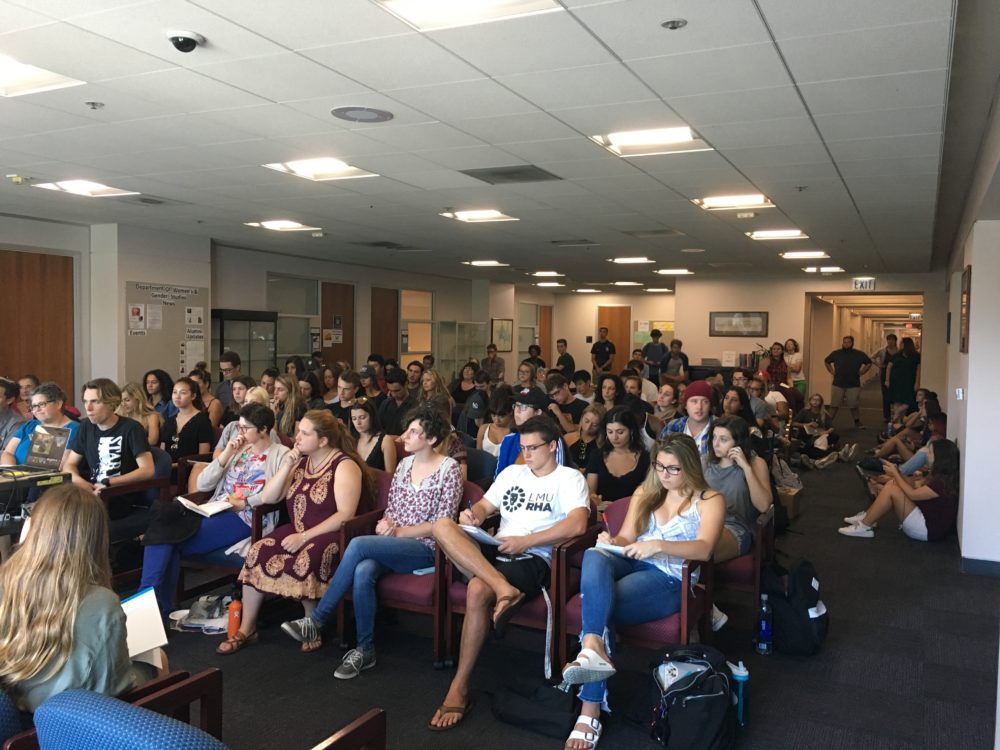
by Thomas Duncan ’19
On September 6, 2017, the LMU History and African American Studies Departments held a panel discussion on Confederate monuments in response to recent events in Charlottesville, VA. The talk featured Professors [Carla] Bittel, [Amy] Woodson-Boulton, and [Elizabeth] Drummond from the History Department, and Professors [Marne] Campbell, [Jennifer] Williams, and [Stefan] Bradley from the African American Studies Department.
Each professor gave a short talk regarding the statues, their history, and their purpose. Dr. Bittel discussed the Lost Cause Mythology, arguing that many in the South have been taught to view the Civil War as a war of Northern aggression rather than slavery. These mistruths were accepted because the North had an economic interest in mending its relationship with the South. Dr. Campbell then spoke on the context of these statues, arguing that because most Civil War monuments were built during a period of great violence against African Americans that they should be taken down. Jim Crow laws and over one thousand lynchings during the Reconstruction period inherently means that many Confederate statues were built in a context of African-American oppression. Dr. Williams echoed these sentiments when she spoke of modern-day racism, highlighting that many claim slavery and racism are over yet we still have statues of Civil War racist slave holders across the nation. She challenged audience members to ask themselves, ‘Who loses at these monuments?’ Dr. Williams added that while the South lost the war, they won the nation. Professors Woodson-Boulton and Drummond added a global perspective to this issue. Dr. Woodson-Boulton pointed to the statues of the infamous colonialist Cecil Rhodes at the University of Cape Town in South Africa and Oxford University. The statue in South Africa was taken down after years of students claiming it stood for Apartheid South Africa while the monument in Oxford remained, despite student votes to remove it, because Oxford feared losing donations. This example provides an interesting comparison to Charlottesville because they took place on college campuses with vastly different outcomes. Dr. Drummond also compared memorials erected in post-Nazi Germany and in post-Reconstruction United States. In Germany, the victims of the Holocaust were memorialized in very public places. Dissimilarly, the U.S. built statues of leaders of the rebellious South and did not memorialize the slaves slaughtered during the centuries of slavery in the U.S.
After these presentations came a rousing question-and-answer session. The group wondered how to ethically take down Confederate statues. Dr. Bradley pointed to St. Louis, where a statue was taken down and placed in a Civil War museum. Another student asked if statues on curated battlefields with museums should remain standing. Dr. Bittel asserted that context mattered and a place like a battlefield has historical context. Dr. Bradley argued that those who left the U.S., and fought a war to remain outside the U.S., do not under any circumstances deserve a statue. Another student asked why it’s so hard to dismantle the monuments. Dr. Bittel replied that many statues were purchased and built by private groups, not local governments. This, Dr. Drummond added, was a key part of the debate, as these privately purchased statues stand on public land.
Professor Bradley spoke in closing. He gave an impassioned charge to action to the students present, quoting, “Until the lion learns to speak the tales of hunting will be weak.” He asked students to question whose history is told at the statues, to “interrogate history,” and urged students to voice their opinions and protest what they think is wrong in order for a culture shift to occur.
For the Loyolan’s coverage of the event, click here.



